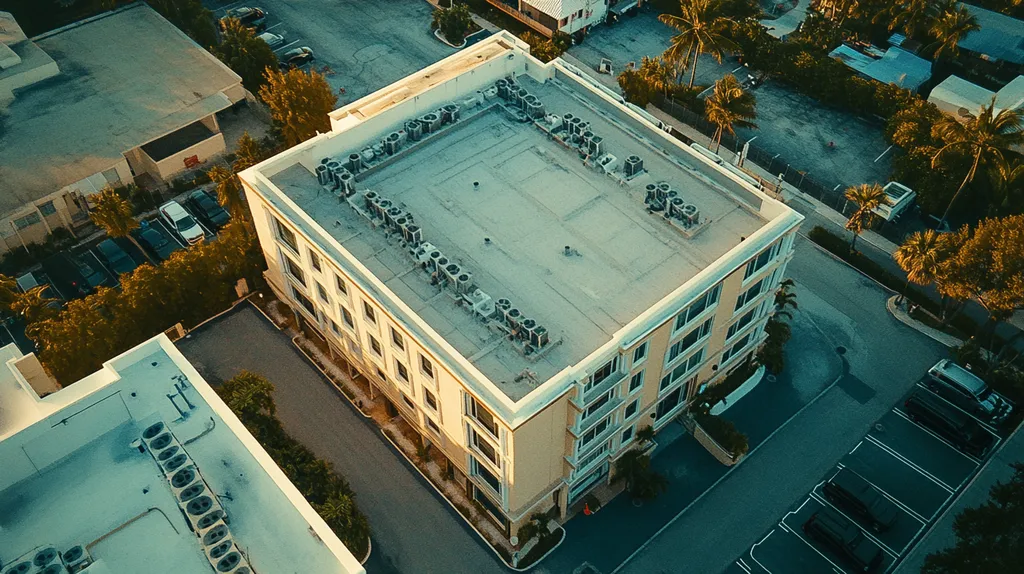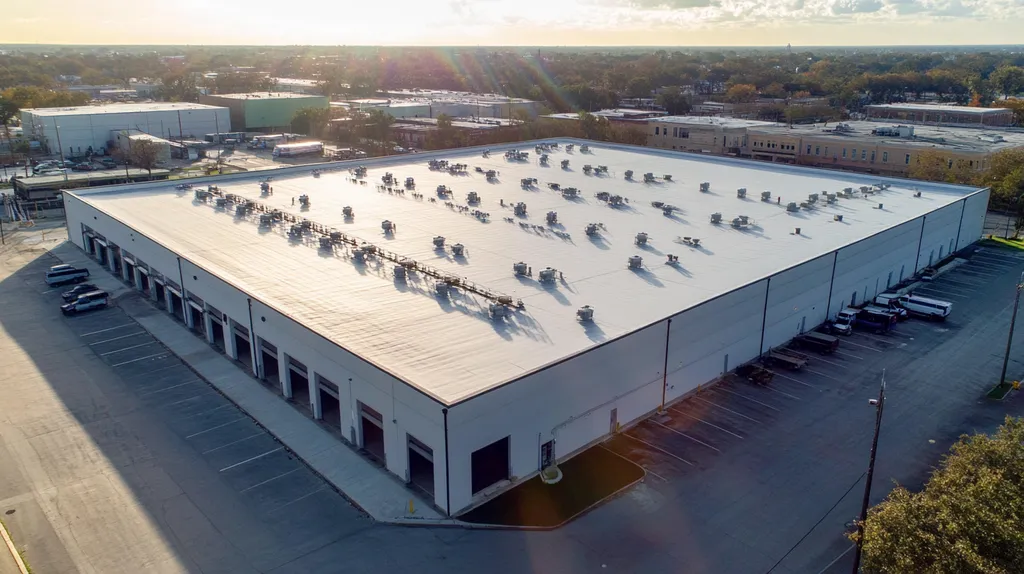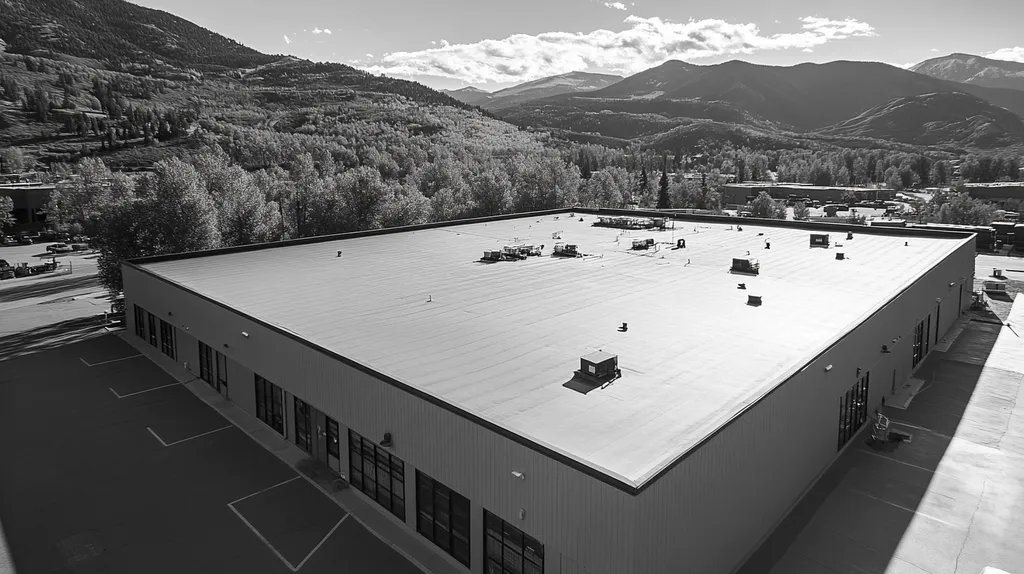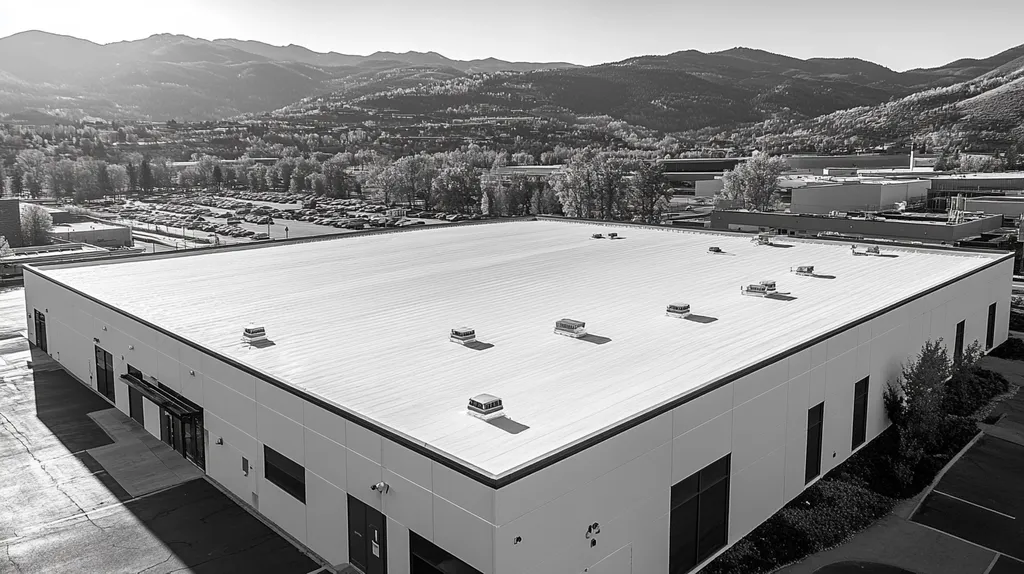The commercial roofing industry’s traditional approach to UV protection is failing building owners, with studies showing up to 80% of roof replacements stemming from inadequate UV resistance. Despite billions spent annually on protective coatings and treatments, premature degradation continues to plague facilities across climate zones.
Current protective strategies, from basic acrylic coatings to complex membrane systems, often fall short of their promised performance. The resulting damage costs property owners an estimated $3.3 billion yearly in repairs and replacements.
This analysis challenges conventional UV protection methods while exploring why established solutions consistently underperform—and what that means for the future of commercial roofing.
SECTION 1: CURRENT PRACTICES
The relentless assault of ultraviolet (UV) rays on commercial roofs is a critical concern for savvy property owners and facility managers alike. Research indicates that roofs lacking adequate UV protection can start to deteriorate in as little as five years under harsh sunlight. This accelerated wear and tear not only shortens the roof’s lifespan but also inflates maintenance costs and disrupts daily operations. To navigate the murky waters of UV resistance, it’s essential to grasp the current practices. This section will dive into the popular UV-resistant coatings, the methods of application, and the essential industry standards that outline effective UV protection.
Common UV-Resistant Coatings Used
The roofing realm boasts a range of UV-resistant coatings engineered to shield roofs from the destructive power of sunlight. Key players in this category include elastomeric coatings, reflective roof coatings, and silicone-based sealants. Many of these options harness cool roof technologies, reflecting sunlight and reducing heat absorption, which can lead to lower energy bills.
However, caution is warranted— not all coatings are created equal. For instance, elastomeric coatings may develop cracks over time if neglect or improper application rears its ugly head. Conversely, silicone coatings bring flexibility to the table but might not stick as well in certain conditions. Property owners must carefully weigh each option’s benefits against its limitations.
Moreover, as technology progresses, new and improved coatings emerge on the market. Yet, many property owners cling to time-tested methods without fully considering the long-term ramifications of their decisions. With modern sustainability demands on the rise, exploring innovative roofing solutions is increasingly vital.
Application Methods and Limitations
Applying UV-resistant coatings isn’t a one-size-fits-all process; it involves various methods including spray, roll-on, and brush application. Each method brings its own set of advantages and challenges. For example, spray applications can cover large areas swiftly, but they often necessitate specialized equipment and stringent safety protocols.
The chosen application method can dramatically influence the coating’s effectiveness. If applied haphazardly, uneven coverage may result, diminishing the material’s ability to repel UV rays efficiently. Entrusting these tasks to trained professionals is crucial to guarantee stellar results.
Environmental conditions also play a significant role during application. High humidity or low temperatures could lead to flaws, compromising the bond between the coating and the roof. Property owners need to recognize these limitations to uphold the integrity of their UV protection strategies.
Industry Standards for UV Protection
The roofing landscape operates under various standards for UV protection, established by organizations like the Cool Roof Rating Council (CRRC) and the American Society for Testing and Materials (ASTM). These benchmarks offer guidance on the reflectivity of roofing materials and their performance against the degradation caused by UV exposure.
For instance, CRRC certification assists property owners in identifying materials that meet stringent reflectance and emittance criteria. However, not all roofing products willingly submit to this certification process, resulting in inconsistencies in quality and performance across the board.
Moreover, compliance with these standards isn’t universally mandated, permitting some manufacturers to put forth products that operate well outside established best practices. To ensure effective UV protection, property owners must be diligent in researching and selecting materials that align with industry standards.
SECTION 2: SYSTEMIC ISSUES
Ultraviolet (UV) rays don’t just give sunbathers a dose of Vitamin D; they also relentlessly assault commercial roofing systems, leading to systemic challenges that can cause significant harm. The consequences are not trivial—studies suggest that UV damage might chop up to 30% off the lifespan of roofing materials. To get ahead of potential roof failures and avoid costly repairs, it’s vital to tackle issues such as material durability, maintenance habits, and design vulnerabilities.
Inadequate Material Durability
Many commercial roofing materials simply lack the resilience required to fend off the relentless onslaught of UV rays. Standard roofing membranes often aren’t crafted specifically to resist long-term UV degradation. This gap can quickly result in issues such as cracking, blistering, and a noticeable drop in insulation performance.
Take traditional asphalt-based roofing, for example. These materials tend to succumb to sunlight more swiftly, leaving property owners to contend with costly repairs and soaring energy bills due to declining efficiency. Upgrading to specialized UV-resistant materials not only mitigates these risks but also prolongs the roof’s lifespan.
Moreover, the absence of UV-resistant coatings on certain roofs amplifies this concern. These protective layers serve as critical shields against harmful rays; without them, roofs face a heightened risk of premature wear and tear, leading to more frequent replacements.
Ultimately, investing in materials specifically engineered for UV resilience can result in substantial savings for property owners down the line. It’s essential to factor in these long-term benefits when planning any roofing project to avoid unforeseen complications.
Insufficient Maintenance Protocols
A well-timed maintenance regimen is crucial for maximizing the longevity of commercial roofing systems, especially in the face of UV exposure. Yet, many facilities often find themselves lacking a proactive approach to maintenance. Skipping routine inspections and repairs can cause minor issues to swell into major headaches.
For instance, small cracks that allow UV rays to gain a foothold can spiral into extensive material degradation over time. If left unchecked, these cracks facilitate a cascade of issues, eventually necessitating far more invasive repairs or an outright roof replacement. A well-crafted maintenance protocol should focus on thoroughly inspecting seams, flashings, and other vulnerable components.
In addition, neglecting to clean roofing surfaces can speed up deterioration rates. Built-up debris can trap both heat and moisture, intensifying the impact of UV rays. As such, maintaining a diligent cleaning schedule is essential to keeping roofs in peak condition.
Establishing a maintenance routine centered on UV prevention can bolster roofing durability significantly. Property managers and owners must prioritize these practices to ensure long-lasting performance and minimize costs associated with roofing failures.
Vulnerabilities in Edge and Perimeter Details
Edges and perimeter details of a roof are pivotal in warding off UV damage. Unfortunately, many roofing systems showcase weaknesses in these areas that can lead to severe consequences. Poorly executed detailing can create avenues for water intrusion and heightened UV exposure.
For instance, insufficient flashing or poorly constructed edge terminations may invite moisture, leading to premature degradation of roofing materials. As water infiltrates, the roof’s ability to reflect UV rays falters, accelerating wear and tear.
Furthermore, if design considerations are not meticulously addressed, these vulnerable areas can turn into hotspots for damage, especially during shifting weather patterns. The resulting temperature fluctuations can exacerbate material fatigue, leading to increased repair challenges and costs.
Focusing on upgrading edge and perimeter designs can help mitigate these risks. Implementing proper detailing with UV-resistant materials and effective sealants strengthens these crucial areas against UV damage and improves overall roofing durability.
SECTION 3: MISSED OPPORTUNITIES
Many commercial property owners underestimate the insidious impact of ultraviolet (UV) rays on their roofing systems. With an alarming 80% of commercial roofs left exposed to these harmful rays, the risks are substantial. This oversight can precipitate costly repairs and premature roof replacements, doing a disservice to both wallets and roofs. Areas ripe for improvement include advanced waterproofing technologies, climate-specific coating choices, and the often-ignored benefits of reflective roof coatings. By addressing these opportunities, property owners can significantly boost their roofs’ longevity and performance.
Overlooking Advanced Waterproofing Technologies
Sticking to traditional waterproofing methods is a common pitfall among commercial property owners, often resulting in inadequate protection against today’s environmental challenges. Innovative solutions such as liquid-applied membranes and spray polyurethane foams can dramatically enhance a roof’s defense against moisture infiltration. These products create a seamless barrier, minimizing the risk of leaks and structural damage.
What’s even better? Many of these advanced waterproofing solutions come equipped with UV-resistant components, boosting their durability against sunlight. For instance, modified bitumen systems excel at waterproofing while effectively resisting UV degradation. Transitioning to these modern alternatives not only extends the lifespan of roofs but also helps keep maintenance costs down in the long run.
Failing to embrace these cutting-edge technologies can create vulnerabilities that lead to significant roof failures. For property owners, investing in innovative waterproofing is essential for safeguarding assets and budgets. By moving towards these modern methods, the risks associated with UV damage can be minimized.
Neglecting Climate-Specific Coating Selection
A significant oversight is the tendency to disregard local climate conditions when selecting roofing materials. Different geographic areas present unique environmental challenges, which can profoundly influence roof performance. Regions with high humidity, for example, require coatings that function distinctly differently from those needed in arid climates.
Property owners often default to a one-size-fits-all solution, resulting in increased thermal stress and the potential breakdown of materials. Choosing a coating tailored to specific climate conditions not only enhances UV resistance but also optimizes overall roof performance.
Cool roofs equipped with elastomeric coatings shine in hot climates by reflecting sunlight, thus keeping roof temperatures lower and extending service life. Conversely, roofs situated in colder regions might benefit from coatings designed to withstand ice and snow buildup. A careful evaluation of environmental factors is critical for maximizing roofing durability.
Underutilizing Reflective Roof Coatings
Despite their myriad benefits, reflective roof coatings are frequently overlooked in commercial roofing strategies. These coatings have the potential to significantly cut down on heat absorption, translating into lower energy costs and a more comfortable indoor environment. By reflecting harmful UV rays, they effectively shield underlying roofing materials from premature degradation.
Research shows that reflective coatings can reduce roof surface temperatures by up to 40 degrees Fahrenheit! This reduction not only boosts energy efficiency but can also lengthen a roof’s lifespan. Yet, many building owners remain steadfast with traditional materials that soak up heat rather than deflect it.
Ignoring the advantages of reflective coatings can lead to inflated cooling costs and rising maintenance demands over time. Property owners need to recognize that investing in reflective technologies can provide long-term savings and increased operational efficiency. Adopting these smart solutions is a proactive approach to enhancing a roof’s resilience against damaging UV radiation.
SECTION 4: ROOT CAUSES
Urgent action is required to combat the relentless threat of ultraviolet (UV) rays against commercial roofs. These pesky rays can wreak havoc, leading to a staggering reduction in roof lifespan by as much as 50% without proper UV protection. Pinpointing the root causes of insufficient UV resistance is crucial for fortifying future roofs against these destructive forces.
Lack of Comprehensive Roof Evaluations
A glaring issue in the realm of UV resilience is the widespread absence of comprehensive roof evaluations. Often, property owners settle for quick, surface-level inspections, inadvertently overlooking deeper problems that UV damage can exacerbate. Thorough assessments are vital for uncovering vulnerabilities lurking in roofing materials.
For instance, by neglecting to inspect the condition of the roof membrane, facility managers may miss the opportunity to apply specialized UV-resistant coatings, which are essential for prolonging a roof’s lifespan. A proactive evaluation strategy could pinpoint weak spots before they balloon into costly crises.
Additionally, many facility managers may not recognize which areas of their roofs are particularly vulnerable to UV damage. This lack of targeted evaluation leads to decisions based on scant information, ultimately amplifying financial and maintenance risks.
In other terms, ignoring comprehensive evaluations is akin to living with a leaky roof while pretending all is well—it inevitably leads to higher maintenance costs. By refining the evaluation process, property owners can ensure their roofs remain resilient and effective for the long haul.
Inadequate Training for Roofing Personnel
Another foundational concern is the inadequate training of roofing personnel. Many contractors enter the field lacking the in-depth knowledge necessary for effectively implementing UV-resistant strategies. This gap results in installations that can falter under the stress of UV exposure.
For example, improperly applied coatings or membranes may fail to hold up against UV damage, leading to leaks and structural vulnerabilities. The construction industry must recognize the urgency of continuous training to maintain high standards for roof performance.
Moreover, with rapid advancements in roofing technology, many workers are blissfully unaware of modern materials and methods that offer enhanced UV resistance. A failure to upskill threatens to replace robust standards with outdated practices that can compromise the integrity of roofs.
In summary, investing in comprehensive training for roofing teams is non-negotiable. Bridging this knowledge gap ensures roofs are well-equipped to handle the trials posed by UV radiation effectively.
Failure to Adopt New Technologies
The roofing industry is significantly hindered by its reluctance to adopt new technologies aimed at bolstering UV resistance. Numerous properties continue to stick with conventional materials that struggle to withstand harsh UV rays.
Take reflective roof coatings and advanced synthetic membranes, for instance—despite their proven effectiveness, they remain sidelined in many regions. Property owners who remain oblivious to these innovations may be sabotaging their roofs, inviting premature wear and tear.
The pace of technological advancements often leaves older roofing systems vulnerable, as they were not designed to endure modern UV exposure levels. Without embracing innovation, roofs risk decreased operational efficiency and long-term safety concerns.
Ultimately, making a commitment to adopt cutting-edge technologies should be a top priority. A proactive approach will not only shield investments but also modernize roofing practices to align with the durability and efficiency standards of the 21st century.
DATA DRIVEN EVIDENCE
In an age where ultraviolet (UV) damage can trigger costly repairs or even necessitate roof replacements, the stakes for commercial property owners are undeniably high. Research reveals that roofs without UV protection can start to show signs of significant wear in as little as five years. This section delves into critical data on UV damage, showcases notable roofing success and failure stories, and highlights the energy and cost savings associated with effective UV protection.
Statistical Impact of UV Damage on Roofs
Statistical analysis underscores the pressing need to combat UV damage. Studies indicate that roofs exposed to direct sunlight can lose as much as 25% of their structural integrity within the first five years. Materials such as modified bitumen and traditional asphalt are particularly vulnerable to thermal expansion and contraction, exacerbated by UV exposure.
UV rays contribute to harmful effects like surface cracking and material degradation, ultimately resulting in leaks. Research suggests that roofs lacking sufficient UV protection have an average lifespan of only 10-15 years, whereas those equipped with advanced coatings can last over 30 years.
The financial implications are also significant. When UV damage is ignored, property owners could incur repair costs upwards of $2,000-$3,000 per 1,000 square feet. Clearly, initiating strategies that bolster a roof’s UV resistance is essential.
Tackling these risks not only prolongs the lifespan of roofing systems but also enhances overall building sustainability, translating into substantial long-term financial benefits.
Case Studies of Roof Failures and Successes
Real-world case studies offer invaluable insights into the consequences of UV exposure on roofing systems. Take, for instance, a high-rise office building in Arizona that experienced a roof failure within just eight years due to severe UV degradation. The resulting replacement cost was more than $150,000.
In contrast, a similar facility that chose a reflective white TPO roof enjoyed an impressive 24% annual energy savings. This UV-protected roof lasted over 20 years without significant issues, exemplifying the advantages of investing in robust UV-resistant technologies.
Another striking example comes from a manufacturing facility that faced severe leaks in its tenth year, largely due to outdated materials lacking UV protection. Once upgraded with a UV-resistant membrane, their maintenance expenses decreased by nearly 40% annually.
These case studies starkly illustrate the benefits of proactive UV protection compared to the pitfalls of neglecting proper roofing strategies, underscoring the importance of reliable materials for durability and cost-effectiveness.
Energy and Cost Savings from UV Protection
Investing in UV protection can significantly enhance roof longevity while also contributing to impressive energy savings. Research has shown that commercial roofs equipped with reflective coatings can slash cooling costs by as much as 30%, which is vital in hotter climates during peak summer months.
Furthermore, buildings that feature effective UV resistance often report lower overall maintenance costs. By reducing degradation, facility managers can sidestep substantial unplanned expenses linked to emergency repairs or early roof replacements.
In fact, an analysis of various facilities indicated that those using UV-resistant materials commonly experienced a return on investment in just three years, revealing that initial expenses can pale in comparison to long-term savings.
In summary, the financial benefits of UV protection manifest through not only reduced energy consumption but also markedly lower maintenance costs over time, making a compelling case for improved roofing strategies.
SECTION 6: ALTERNATIVE SOLUTIONS
As commercial property owners grapple with the relentless assault of ultraviolet rays, the need for effective roofing alternatives couldn’t be clearer. Traditional roofing methods often falter against UV-induced deterioration, which can slashes a roof’s lifespan by as much as 30%. In light of these statistics, exploring alternative solutions isn’t just wise—it’s imperative. This section uncovers three advanced strategies to bolster UV resistance and enhance roof durability, all while maintaining peak performance.
Implementing Silicone and Acrylic Coatings
Silicone and acrylic coatings have emerged as top contenders in the battle against UV rays. These coatings form a resilient barrier that reflects harmful UV radiation, significantly curbing heat accumulation. Studies reveal that roofs treated with these coatings can enjoy up to 15 additional years of lifespan compared to their uncoated counterparts.
The application process is not only streamlined but also minimizes downtime, allowing facilities to keep operations running smoothly. Compatible with a variety of roofing types, including single-ply membranes and metal roofs, these coatings offer remarkable versatility for diverse commercial and industrial environments.
In addition to extending longevity, these coatings also enhance waterproofing capabilities. This dual functionality boosts energy efficiency and reduces long-term maintenance needs. For facilities on the hunt for a cost-effective yet robust solution, silicone and acrylic coatings stand out as hard-to-ignore options.
Furthermore, many of these products boast an environmentally friendly profile, often containing low or zero volatile organic compounds (VOCs). This aspect aligns seamlessly with rising sustainability concerns and can contribute to LEED certification efforts. For property managers looking to champion sustainability, these coatings fit the bill perfectly.
Utilizing Metal and TPO Roofing Systems
Metal and thermoplastic olefin (TPO) roofing systems are gaining momentum due to their exceptional UV resistance. Metal roofs reflect a noteworthy percentage of UV radiation, which prevents heat buildup and significantly extends their lifespan. Studies suggest that properly installed metal roofs can last an impressive 50 years or more.
TPO roofing, characterized by its bright white surface, excels in UV protection while also promoting energy savings via its reflective properties. This roofing material is especially popular for flat and low-slope roofs, making it a flexible fit across various commercial applications.
In addition to resisting UV damage, both systems actively lower cooling costs. By minimizing heat absorption, they help maintain a consistent indoor climate, resulting in reduced energy bills. For facilities located in regions prone to extreme weather, their robustness becomes even more apparent.
Lastly, metal and TPO roofs are generally resistant to punctures and tears, which translates to lower maintenance requirements over their lifespan. Property owners investing in these solutions can anticipate a strong return on investment, thanks to their impressive durability and energy efficiency.
Integrating UV-Resistant Coatings with Cool Roof Systems
Combining UV-resistant coatings with cool roof technologies creates a powerful barrier against the sun’s relentless rays. Cool roofs, known for their highly reflective surfaces, substantially reduce heat transfer and energy consumption. When these roofs are paired with UV-resistant coatings, they form a comprehensive protective armor.
These advanced technologies not only boost UV performance but also help mitigate the urban heat island effect, making them particularly advantageous for structures in hot climates. Local governments are increasingly incentivizing the installation of cool roofs due to their favorable environmental impact.
By applying UV-resistant coatings atop cool roofing materials, property managers can significantly prolong the entire roof system’s lifespan. This strategy effectively amplifies the benefits of both technologies, ensuring maximum protection against weather-related wear and tear.
Additionally, property owners may also benefit from government rebates and tax incentives for implementing these innovative solutions. As the push for energy-efficient buildings grows, integrating UV-resistant coatings with cool roof systems positions facilities at the forefront of sustainable practices.
Moving Forward
With UV damage driving up to 80% of commercial roof replacements and costing property owners billions annually, the imperative for change is clear.
Traditional UV protection strategies have proven inadequate against increasingly harsh environmental conditions, while promising technologies like advanced coatings and cool roof systems remain underutilized.
The data speaks volumes: buildings employing modern UV-resistant solutions report 30% lower cooling costs and double the average roof lifespan.
Success requires a wholesale shift away from outdated practices toward comprehensive UV protection strategies incorporating climate-specific materials, proper training, and regular maintenance.
The choice is stark: evolve UV protection approaches now, or face accelerating repair costs and premature roof failures in an increasingly hostile climate.
FREQUENTLY ASKED QUESTIONS
Q. What are the current practices for a commercial roof’s UV resistance?
A. Current practices include using UV-resistant coatings like elastomeric or silicone sealants. Popular applications entail spray, roll-on, or brush methods, but effectiveness varies. Property owners must evaluate coatings based on performance standards and their specific roofing needs.
Q. How does inadequate material durability affect industrial roofs?
A. Insufficient material durability leads to issues like cracking and blistering, causing costly repairs. Standard materials often struggle against UV rays, making it essential to choose specialized options designed to withstand harsh conditions. Upgrading materials can significantly enhance roof longevity.
Q. What opportunities are often missed regarding commercial roof UV protection?
A. Many property owners overlook advanced waterproofing technologies and climate-specific coatings when selecting their roofs. Reflective coatings are commonly disregarded, despite their ability to enhance energy efficiency and prolong lifespan. Addressing these gaps can lead to substantial improvements in roof performance.
Q. What root causes contribute to insufficient UV resistance in roofing systems?
A. A lack of comprehensive roof evaluations often hinders identifying UV vulnerabilities. Additionally, insufficient training for roofing personnel results in inadequate installations, while failure to adopt new technologies leaves roofs exposed to damage. Addressing these issues is critical for improving roof resilience.
Q. What does data-driven evidence say about UV damage on commercial roofs?
A. Research indicates roofs without UV protection can show wear in just five years, potentially losing 25% of structural integrity. Case studies demonstrate financial benefits of UV-resistant technologies, highlighting significant cost savings and improvements in longevity when implemented effectively.
Q. What alternative solutions can enhance a commercial roof’s UV resistance?
A. Alternatives like using silicone or acrylic coatings and installing metal or TPO roofing systems can significantly boost UV resistance. Integrating these coatings with cool roof technologies provides an effective shield against harmful rays while enhancing energy efficiency and reducing maintenance needs.
Q. How can I ensure a commercial roof is effective against UV rays?
A. To ensure effectiveness, select high-quality, UV-resistant materials, and follow a strict maintenance schedule. Regular inspections and timely repairs will prevent minor issues from escalating, thus extending the roof’s lifespan against UV damage. Always consult with professionals for appropriate applications.











